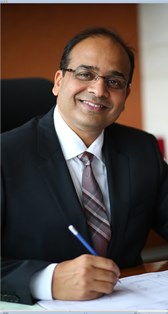 Arvind Jain, Managing Director – Pride Group
Arvind Jain, Managing Director – Pride Group
Mumbai city was originally reclaimed from the sea by joining seven islands, with the intention of creating a shipping and trading hub for the British. However, the city that resulted from this exercise attracted a magnitude of population which was very disproportionate to that in any of the surrounding regions.
The MMR was notified in 1967, in an effort to address the rising problems that the existing inhabitants were facing. Many more areas were included within the region; today, the Mumbai Metropolitan Region includes Greater Mumbai, Thane, Kalyan and Navi Mumbai in addition to many additional towns and villages.
Due to Mumbai’s unique geographical positioning, the growth of urban sprawl in the Mumbai Metropolitan Region has been very lopsided. Until the early ’70s, most of the MMR’s urban built-up area was concentrated in the Island city and its immediate suburbs, so the expansion of real estate development was more or less constrained within this region.
About 3/4th of the population was residing within this relatively small area. However, the city’s road and rail networks expanded remarkably quickly beyond Greater Mumbai, which resulted in growth being driven toward Vashi, Thane, Panvel and Kalyan.
Over the years, this trend has been maintained and accelerated. Today, with available land at an extremely high premium in the primary city, even the furthest suburbs like Khalapur, Uran and Karjat have seen the consumption of their agricultural and forest lands to make way for real estate development.
In the current times, the Mumbai Metropolitan Region is extremely curtailed in its scope for unilateral growth and Mumbai’s resident population has exploded beyond all bounds. Any kind of explosion required a sufficiently large area for its fallout to spread; Mumbai’s population explosion and the real estate development pattern that has resulted is very much akin to the firing of a bullet, with the path being directed by the barrel’s constraints.
In the years to come, we are likely to see a steady thinning-out of the urban population in Mumbai’s central areas and increasing densification of these new growth areas. Meanwhile, the city’s wealthiest inhabitants continue to stay put within the rarefied spectrum of MMR’s ultra-expensive central areas. What we are witnessing today is an accelerated process of social stratification that has been underway in the city for a fairly long period of time.
Over the years, real estate rates have risen astronomically in the original core parts of Mumbai city. Since the pricing trough of 2009, in a period of less than five years, prices have grown in excess of 80%. The growth in the Navi Mumbai and Thane region has been even greater.
Development is now extending into the newer, outer regions. Most of the growth in Mumbai’s residential real estate sector growth has been the result of the increased supply in these regions, and there has been a corresponding population shift from the original MMR to these newly developed locations.
This is the trend that will prevail over the next couple of decades, and will result in a significant outward migration from the MMR. This phenomenon is not solely on account of the ever-rising property prices and escalating infrastructure deficit within the Mumbai Metropolitan Region, but also because these new regions are attracting national and international manufacturing companies.
Because of the generation of jobs that has ensued, many of these extended markets are now coming into strength as independent economic catchments that have their own workplace hubs generating local demand for real estate. However, the main city is now also striving to improve by adding infrastructure to accommodate and deal within the constant inward migration. This is having a positive impact on the primary influence zone of Mumbai City and its immediately neighbouring locations.
These infrastructure projects are basically operating as retention magnets for the limited but, at a market level, significant population segment whose economic lives are linked to the primary business activities in the city, and who can afford the real estate prices involved in owning homes in Mumbai’s most expensive locations.
